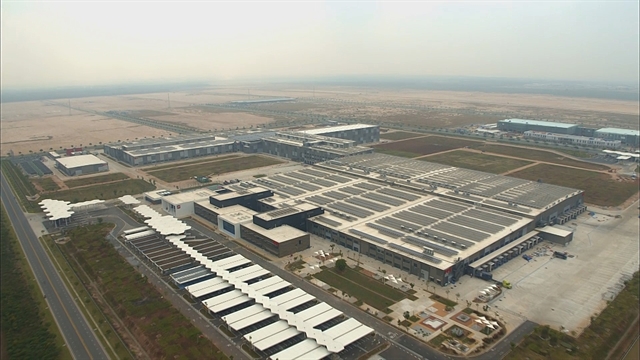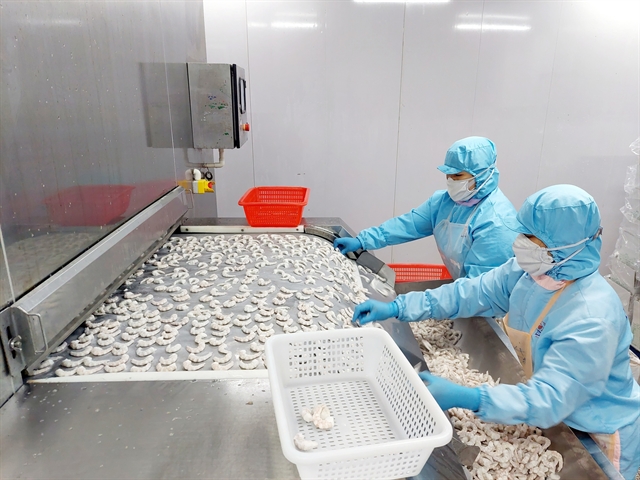 Economy
Economy

 |
| Vietnamese shrimp processed in a factory. VNA/VNS Photo Thanh Vân |
HÀ NỘI — Challenges are looming on the horizon for the shrimp industry as high inflation has begun to sap global demand for Vietnamese seafood.
Trương Đình Hòe, general secretary of the Vietnam Association of Seafood Exporters and Producers, remarked that high inflation in some countries, coupled with volatile exchange rates, had made Vietnamese shrimp more expensive than others.
High inflation had also eroded the countries' domestic consumption, leading to unsold inventory. The combined effects of the mounting prices and the falling sales had resulted in fewer orders from abroad.
"Americans go to restaurants less frequently amid high inflation. The shrimps just aren't selling because people keep tightening their spending," said Hòe.
For the time being, Vietnamese shrimp are at a price disadvantage compared to shrimp from Ecuador and India. In 2021, Ecuador's shrimp output topped a million tonnes, the highest in the world.
Hòe said Ecuador's price advantage comes from its proximity to major shrimp importers. For example, the distance between Ecuador and the US allows the latter to save around $1 in transportation costs per kilo, enough to make Ecuadorian shrimps a real bargain for US consumers.
It is also worth noting that Việt Nam's shrimp exports stood at $360 million in October, down 14 per cent from the same month last year. October was the third month in 2022 that witnessed a fall in shrimp sales overseas.
Lê Bảo Toàn, finance manager of the Minh Phú - Hậu Giang Seafood JSC, said his company saw its shrimp exports to the EU and the US plummet in recent months. Its unsold inventory rose to VNĐ5.3 trillion by late September, 16 per cent higher than in January.
Meanwhile, its financial costs were rising due to rising interest rates and volatile exchange rates. Specifically, the costs climbed to VNĐ88.5 billion in Q3, four times higher than in the same quarter last year.
Hồ Quốc Lực, chairman of the Sao Ta Foods JSC, was concerned that orders from overseas have been on the slide since late Q3, and there is a great deal of uncertainty about new orders in 2023.
"Customer buying patterns shifting away from high-end products amid high inflation and the fierce competition among shrimp producers have led to a high level of unsold inventory," said Lực.
Sa Ta Foods JSC made a revenue of VNĐ13.9 million in November, down 28 per cent from the figure in October and being the second lowest monthly revenue in 2022.
Amid the unfavourable conditions, financial manager Toàn said his company would focus on high-value-added products to boost its profitability. Additionally, it would reduce its unsold inventory through product sell-offs and use the revenue to deleverage its balance sheet.
"Our unsold inventory will be sold off, even at a loss, if inflation keeps rising. We need to keep our bank loans as low as possible," said Toàn.
General secretary Hòe said the best solution for seafood companies in this tough time is to reduce bank loans and control unsold inventory. Each tonne of shrimp in their unsold inventory costs them around $10,000.
"Seafood companies should not take out additional bank loans. Otherwise, they would fall into hardship because of the rising lending rates," Hòe added.
The situation is expected to turn around in Q1/2023 following the re-opening of the Chinese market and the drops in inflation in the US and the EU, a big push to demand recovery.
"Shrimp sales should pick up in Q1 or Q2 rather than in January as usual. The market must not decline forever," said Hòe.
Although he was uncertain about how the market would fare in Q3/2023, he still believed that the annual revenue target of $10 billion set for 2023 would be within reach.
Võ Văn Phục, general director of the Vietnam Clean Seafood Corporation, was concerned that the Vietnamese shrimp industry is more of a processing-based industry than a farming-based one.
With such a structure, the industry risks being priced out of high-end segments by its rivals, whose processing techniques are expected to catch up in several years, according to Phục.
For the time being, its rivals are employing intensive farming techniques to put their shrimps at a price advantage over Vietnamese shrimps. Remarkably, Ecuadorian shrimp output is forecast to top 2.5 million tonnes in 2025, equalling global shrimp imports. — VNS




